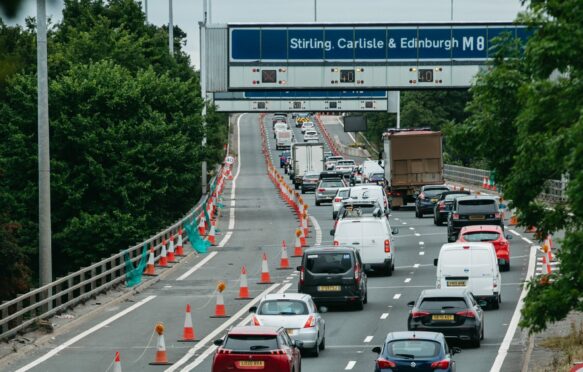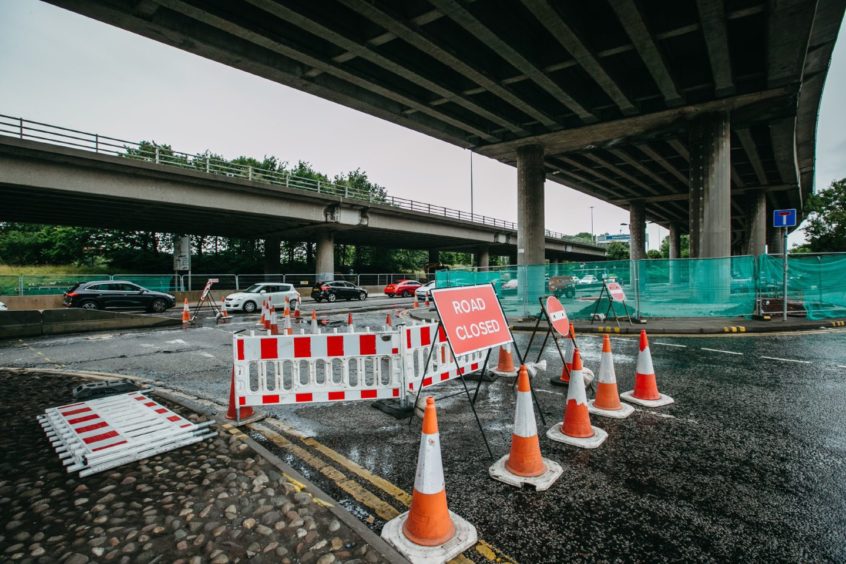
Drivers on Scotland’s busiest motorway have been warned there is no end in sight to the repairs behind crippling tailbacks.
Despite lockdown, motorists have endured long waits for months after lanes were closed on either side of the M8 north of Glasgow city centre as emergency work on supporting pillars continues.
Traffic is restricted on a stretch of motorway a mile north of the Kingston Bridge with east-bound queues tailing back on the crossing, one of Britain’s busiest roads carrying around 155,000 vehicles a day, around twice as many as Edinburgh’s Queensferry Crossing.
Delays are getting worse
As more people return to work, tailbacks and delays are getting worse but Amey, the company contracted by Transport Scotland to develop a repair solution for the M8 Woodside Viaducts, says, while the ongoing maintenance work is vital, there is no projected completion date. The firm warns delays on and around the bridge could increase in the coming weeks.
The lane restrictions, according to the firm, are in place to ensure the safety of road workers and drivers while maintenance work and investigations are under way beneath the structure.
Amey added: “The full repair programme is still being developed and the programme dates will be issued via our website in due course. As work intensifies it is likely there may be increased disruption on the local roads.
“During morning and evening peak times, delays of between 10 to 15 minutes are common due to the traffic volumes. These delays are similar to existing peak delays at this part of the M8. Outwith peak times, delays are generally less than five minutes.
“We would like to thank the public for their patience and understanding while this work is carried out.”
Increasing traffic
The increasing traffic on and around the Kingston Bridge has been a longstanding concern. When it was opened by the Queen Mother in 1970, the crossing was designed to handle 120,000 vehicles a day. It cost £11m, the equivalent of around £180m today.
In 1990, the sheer volume and weight of traffic, combined with poor design and flaws in construction, had resulted in serious structural deterioration. A decade-long renovation programme was initiated to repair and strengthen the bridge.
It has been discovered that further major structural work is now required to ensure its longevity. Motoring organisations said the timing of the M8 works was unfortunate, particularly as traffic levels begin to approach normal again.
RAC head of roads policy, Nicholas Lyes, said: “Major roadworks and essential maintenance will always cause delays and sadly for drivers it’s a case of short-term pain for long-term gain.
“Unfortunately, this next phase of work also happens to coincide with Scotland reopening fully so it is likely to be the source of lot of frustration for those using their vehicles to go back to work.”
Alex Veitch, public policy spokesman for freight transport giant Logistics UK, said maintaining the road network was essential to ensure the safe passage of all road users.
He added: “But it is imperative that these works are concluded as quickly and safely as possible.”
The Alliance of British Drivers said it was frustrating for motorists when major roadworks take place on busy arteries such as the M8 and where there were no easy alternative routes, adding: “Ideally such major and disruptive works would have been done during lockdown when traffic was light.
“Given the fact that the works are now being done when traffic is back to normal, they should be done as quickly as possible with maximum resources and a clear end date.”

Enjoy the convenience of having The Sunday Post delivered as a digital ePaper straight to your smartphone, tablet or computer.
Subscribe for only £5.49 a month and enjoy all the benefits of the printed paper as a digital replica.
Subscribe © Andrew Cawley
© Andrew Cawley